Flexural Strength of Internally Stiffened Tubular Steel Beam Filled with Recycled Concrete Materials
Abstract
:1. Introduction
2. Experimental Approach
2.1. Preparation of Samples
2.2. Material Properties
2.3. Test Setup
3. Discussion of Experimental Results
3.1. Failure Modes
3.2. Flexural Behaviour and Strength Capacity
3.3. Flexural Stiffness
3.4. Energy Absorption Index
4. Numerical Approach
4.1. Development and Verification of the Numerical Model
4.2. Parametric Studies
4.2.1. Performance of Bending Behaviour
4.2.2. Performance of Stiffness
4.2.3. Performance of Bending Strength
5. Design Guidelines
5.1. Evaluation of the Obtained Flexural Stiffness
5.2. Evaluation of the Obtained Flexural Strength
5.3. Development of the New Analytical Method
- i.
- This method was limited to rectangular CFST beams with internal stiffeners under pure static bending.
- ii.
- iii.
- iv.
- In the classification of the stiffened steel tube of the CFST beam, the effective flat width between the web and stiffener (weff) was used instead of the overall effective tube width (Weff) for estimation of the stiffened slenderness ratio (λst = weff/t). In another words, (λst = weff/t) was used instead of (λ = Weff/t) for the classification.
- v.
- A nominal concrete confinement, which varied considerably based on the slenderness limit, was assumed to have been generated by the steel tube.
- vi.
- The tension-related stress of the concrete, which occurred due to cracking failure, was ignored.
- vii.
- The variations in stress due to the stiffener’s depth and the flange’s thickness were ignored.
- viii.
- Compact section (see Figure 14a): this section was assumed to have rigid-plastic behaviour and the steel stress was assumed to remain within the yielding limit (Fy) at both the tension and compression zones. The concrete compression stress was assumed to be within the limits of the ultimate strength (fcu) and distributed as a rectangular stress block to the N.A. position.
- ix.
- Noncompact section (see Figure 14b): this section was assumed to have elastic-plastic behaviour at the tension zone and elastic behaviour at the compression zone, and the steel stress was assumed to be within the limits of Fy [12,64]. The concrete compression stress was assumed to be within the limits of 0.9fcu and distributed as a triangular stress block to the N.A. position.
- x.
- Slender section (see Figure 14c): this section was assumed to have pure elastic behaviour, and the steel stress was assumed to be within the limits of Fy at the maximum tension face and within the limits of the buckling stress (Fcr) at the maximum compression face [12,64]. For this section, a lower concrete compression stress was assumed, which was taken to be within the limits of 0.8fcu.
- xi.
- Finally, when the forces over the stiffened CFST beam’s cross-section attained equilibrium (see Figure 14), the summarized forms of the new analytical formula for predicting the Mn for each section classification could be expressed as follows:
6. Conclusions
- ➢
- The experimental investigation confirmed that the bending capacity of the suggested prefabricated Slender CFST beams made from two pieces of C-sections was enhanced by about 3.7 times even when filled with 70% replacement recycled concrete material.
- ➢
- Under the static bending load, the prefabricated tubular steel beams (double C-sections) filled with recycled concrete (0, 30%, 50%, and 70%) behaved very similarly to the conventional CFST beams. Additionally, the lips of these C-sections were adequately bonded to the concrete and acted as internal stiffeners for the Slender CFST beam’s cross-section, which delayed the outward buckling failures at their top flanges. For example, the use of recycled aggregate to replace raw aggregate at a proportion of up to 70% resulted in slightly lower flexural stiffness and strength capacity values (−7.2% to −10.7%) compared to those obtained using normal concrete.
- ➢
- Generally, it is worth highlighting that the suggested fabricated steel tube beams’ self-weight was increased substantially due to the effect of concrete infill materials. In turn, the flexural strength capacities of these beams were remarkably enhanced, by approximately 409% and 363%, when using normal concrete and 70% recycled concrete mixtures, respectively. These findings are very important from a structural engineering point of view as, regardless the increment of the beams’ self-weight, they can be used to prospectively determine the scenarios in which this composite system would be reliable for the targeted purpose of construction projects. Cost also played a vital role in the construction design process, which was demonstrated when we compared the cost of the concrete and steel sections in the local market.
- ➢
- The flexural behaviour of tested CFST beam was accurately simulated using the ABAQUS software. The results obtained from the non-linear analyses of FE CFST models that were prepared for investigation of various parameters confirmed that slightly increasing the thickness of the tubes in these models had a major influence on their flexural strengths and stiffnesses as compared to the effects of other parameters. In contrast, a limited degree of influence was achieved when the compressive strengths of the concrete infill material and/or the yielding strengths of the steel tubes were increased.
- ➢
- Lastly, the newly developed analytical method achieved the best prediction of the flexural strength capacities of the internally stiffened CFST beams that were tested and analysed in this study, since it was able to independently consider the influence of internal steel stiffeners along with the effects of the properties of steel tubes and concrete. However, this method was found to only be reliable for the internally stiffened rectangular CFST beams.
Author Contributions
Funding
Institutional Review Board Statement
Informed Consent Statement
Data Availability Statement
Conflicts of Interest
Abbreviations
References
- Zong, Z.; Jaishi, B.; Ge, J.-P.; Ren, W.-X. Dynamic analysis of a half-through concrete-filled steel tubular arch bridge. Eng. Struct. 2005, 27, 3–15. [Google Scholar] [CrossRef]
- Han, L.-H.; Li, W.; Bjorhovde, R. Developments and advanced applications of concrete-filled steel tubular (CFST) structures: Members. J. Constr. Steel Res. 2014, 100, 211–228. [Google Scholar] [CrossRef]
- Wu, D.; Gao, W.; Feng, J.; Luo, K. Structural behaviour evolution of composite steel-concrete curved structure with uncertain creep and shrinkage effects. Compos. Part B Eng. 2016, 86, 261–272. [Google Scholar] [CrossRef]
- Gao, J.; Su, J.; Xia, Y.; Chen, B. Experimental Study of Concrete-Filled Steel Tubular Arches with Corrugated Steel Webs. Adv. Steel Constr. 2014, 10, 99–115. [Google Scholar] [CrossRef]
- Al-Shaar, A.A.M.; Göǧüş, M.T. Performance of Retrofitted Self-Compacting Concrete-Filled Steel Tube Beams Using External Steel Plates. Adv. Mater. Sci. Eng. 2018, 2018, 3284745. [Google Scholar] [CrossRef] [Green Version]
- Yang, Y.-F.; Zhu, L.-T. Recycled aggregate concrete filled steel SHS beam-columns subjected to cyclic loading. Steel Compos. Struct. 2009, 9, 19–38. [Google Scholar] [CrossRef]
- Zhang, Y.-B.; Han, L.-H.; Zhou, K.; Yang, S. Mechanical performance of hexagonal multi-cell concrete-filled steel tubular (CFST) stub columns under axial compression. Thin-Walled Struct. 2018, 134, 71–83. [Google Scholar] [CrossRef] [Green Version]
- Luat, N.-V.; Lee, D.H.; Lee, J.; Lee, K. GS-MARS method for predicting the ultimate load-carrying capacity of rectangular CFST columns under eccentric loading. Comput. Concr. 2020, 25, 1–14. [Google Scholar] [CrossRef]
- Qeshta, I.M.; Shafigh, P.; Jumaat, M.Z.; Abdulla, A.I.; Alengaram, U.J.; Ibrahim, Z. Flexural Behaviour of Concrete Beams Bonded with Wire Mesh-Epoxy Composite. Appl. Mech. Mater. 2014, 567, 411–416. [Google Scholar] [CrossRef]
- Javed, M.F.; Sulong, N.R.; Memon, S.A.; Rehman, S.K.U.; Khan, N.B. FE modelling of the flexural behaviour of square and rectangular steel tubes filled with normal and high strength concrete. Thin-Walled Struct. 2017, 119, 470–481. [Google Scholar] [CrossRef]
- Yang, Y.-F.; Ma, G.-L. Experimental behaviour of recycled aggregate concrete filled stainless steel tube stub columns and beams. Thin-Walled Struct. 2013, 66, 62–75. [Google Scholar] [CrossRef]
- Lai, Z.; Varma, A.; Zhang, K. Noncompact and slender rectangular CFT members: Experimental database, analysis, and design. J. Constr. Steel Res. 2014, 101, 455–468. [Google Scholar] [CrossRef]
- Wang, J.; Shen, Q.; Wang, F.; Wang, W. Experimental and analytical studies on CFRP strengthened circular thin-walled CFST stub columns under eccentric compression. Thin-Walled Struct. 2018, 127, 102–119. [Google Scholar] [CrossRef]
- Wang, W.-H.; Han, L.-H.; Li, W.; Jia, Y.-H. Behavior of concrete-filled steel tubular stub columns and beams using dune sand as part of fine aggregate. Constr. Build. Mater. 2014, 51, 352–363. [Google Scholar] [CrossRef]
- Al Zand, A.W.; Badaruzzaman, W.H.W.; Mutalib, A.A.; Hilo, S.J. Flexural Behavior of CFST Beams Partially Strengthened with Unidirectional CFRP Sheets: Experimental and Theoretical Study. J. Compos. Constr. 2018, 22, 04018018. [Google Scholar] [CrossRef]
- Guler, S.; Yavuz, D. Post-cracking behavior of hybrid fiber-reinforced concrete-filled steel tube beams. Constr. Build. Mater. 2019, 205, 285–305. [Google Scholar] [CrossRef]
- Al-Shaar, A.A.M.; Göğüş, M.T. Flexural behavior of lightweight concrete and self-compacting concrete-filled steel tube beams. J. Constr. Steel Res. 2018, 149, 153–164. [Google Scholar] [CrossRef]
- Liu, J.-P.; Yang, J.; Chen, B.-C.; Zhou, Z.-Y. Mechanical performance of concrete-filled square steel tube stiffened with PBL subjected to eccentric compressive loads: Experimental study and numerical simulation. Thin-Walled Struct. 2020, 149, 106617. [Google Scholar] [CrossRef]
- Al Zand, A.W.; Wan Badaruzzaman, W.H.; Ali, M.M.; Hasan, Q.A.; Al-Shaikhli, M.S. Flexural performance of cold-formed square CFST beams strengthened with internal stiffeners. Steel Compos. Struct. 2020, 34, 123–139. [Google Scholar]
- Ansari, M.; Jeddi, M.; Badaruzzaman, W.; Tahir, M.; Osman, S.; Hosseinpour, E. A numerical investigation on the through rib stiffener beam to concrete-filled steel tube column connections subjected to cyclic loading. Eng. Sci. Technol. Int. J. 2020, 24, 728–735. [Google Scholar] [CrossRef]
- Kwon, Y.B.; Park, S.W. Resistance of circular concrete-filled tubular sections to combined axial compression and bending. Thin-Walled Struct. 2017, 111, 93–102. [Google Scholar] [CrossRef]
- Al Zand, A.W.; Badaruzzaman, W.H.W.; Al-Shaikhli, M.S.; Ali, M.M. Flexural performance of square concrete-filled steel tube beams stiffened with V-shaped grooves. J. Constr. Steel Res. 2020, 166, 105930. [Google Scholar] [CrossRef]
- Lai, M.; Song, W.; Ou, X.; Chen, M.; Wang, Q.; Ho, J. A path dependent stress-strain model for concrete-filled-steel-tube column. Eng. Struct. 2020, 211, 110312. [Google Scholar] [CrossRef]
- Liu, Z.; Lu, Y.; Li, S.; Zong, S.; Yi, S. Flexural behavior of steel fiber reinforced self-stressing recycled aggregate concrete-filled steel tube. J. Clean. Prod. 2020, 274, 122724. [Google Scholar] [CrossRef]
- Nematzadeh, M.; Karimi, A.; Gholampour, A. Pre- and post-heating behavior of concrete-filled steel tube stub columns containing steel fiber and tire rubber. Structures 2020, 27, 2346–2364. [Google Scholar] [CrossRef]
- Qiao, Q.-Y.; Zhang, W.-W.; Mou, B.; Cao, W.-L. Seismic behavior of exposed concrete filled steel tube column bases with embedded reinforcing bars: Experimental investigation. Thin-Walled Struct. 2019, 136, 367–381. [Google Scholar] [CrossRef]
- Chen, Z.; Xu, J.; Chen, Y.; Lui, E. Recycling and reuse of construction and demolition waste in concrete-filled steel tubes: A review. Constr. Build. Mater. 2016, 126, 641–660. [Google Scholar] [CrossRef]
- Ou, Z.J. The practice of concrete filled steel tube piers to bridges: A review. In Applied Mechanics and Materials; Trans Tech Publications Ltd.: Kapellweg, Switzerland, 2013; Volume 405, pp. 1602–1605. [Google Scholar]
- Kozielova, M.; Marcalikova, Z.; Mateckova, P.; Sucharda, O. Numerical Analysis of Reinforced Concrete Slab with Subsoil. Civ. Environ. Eng. 2020, 16, 107–118. [Google Scholar] [CrossRef]
- Montoya, E.; Vecchio, F.J.; Sheikh, S.A. Compression Field Modeling of Confined Concrete: Constitutive Models. J. Mater. Civ. Eng. 2006, 18, 510–517. [Google Scholar] [CrossRef]
- Červenka, J.; Papanikolaou, V.K. Three dimensional combined fracture–plastic material model for concrete. Int. J. Plast. 2008, 24, 2192–2220. [Google Scholar] [CrossRef]
- Ahmed, W.; Lim, C. Production of sustainable and structural fiber reinforced recycled aggregate concrete with improved fracture properties: A review. J. Clean. Prod. 2020, 279, 123832. [Google Scholar] [CrossRef]
- Huang, L.; Yang, Z.; Li, Z.; Xu, Y.; Yu, L. Recycling of the end-of-life lightweight aggregate concrete (LWAC) with a novel approach. J. Clean. Prod. 2020, 275, 123099. [Google Scholar] [CrossRef]
- Alsharie, H.; Masoud, T.; Abdulla, A.I.; Ghanem, A. Properties of lightweight cement mortar containing treated pumice and limestone. J. Eng. Appl. Sci. 2015, 10, 96–101. [Google Scholar]
- Su, S.; Li, X.; Wang, T.; Zhu, Y. A comparative study of environmental performance between CFST and RC columns under combinations of compression and bending. J. Clean. Prod. 2016, 137, 10–20. [Google Scholar] [CrossRef] [Green Version]
- Xu, J.; Wang, Y.; Ren, R.; Wu, Z.; Ozbakkaloglu, T. Performance evaluation of recycled aggregate concrete-filled steel tubes under different loading conditions: Database analysis and modelling. J. Build. Eng. 2020, 30, 101308. [Google Scholar] [CrossRef]
- Yang, Y.-F.; Han, L.-H.; Zhu, L.-T. Experimental Performance of Recycled Aggregate Concrete-Filled Circular Steel Tubular Columns Subjected to Cyclic Flexural Loadings. Adv. Struct. Eng. 2009, 12, 183–194. [Google Scholar] [CrossRef]
- Yang, Y.F.; Man, L.H. Compressive and flexural behaviour of recycled aggregate concrete filled steel tubes (RACFST) under short-term loadings. Steel Compos. Struct. 2006, 6, 257–284. [Google Scholar] [CrossRef]
- Xu, J.J.; Zhao, X.Y.; Chen, Z.P.; Liu, J.C.; Xue, J.Y.; Elchalakani, M. Thin-Walled Structures Novel prediction models for composite elastic modulus of circular recycled aggregate concrete-filled steel tubes. Thin-Walled Struct. 2019, 144, 106317. [Google Scholar] [CrossRef]
- Karimi, A.; Nematzadeh, M.; Mohammad-Ebrahimzadeh-Sepasgozar, S. Analytical post-heating behavior of concrete-filled steel tubular columns containing tire rubber. Comput. Concr. 2020, 26, 467–482. [Google Scholar]
- Mouli, M.; Khelafi, H. Strength of short composite rectangular hollow section columns filled with lightweight aggregate concrete. Eng. Struct. 2007, 29, 1791–1797. [Google Scholar] [CrossRef]
- Fu, Z.; Ji, B.; Wu, D.; Yu, Z. Behaviour of lightweight aggregate concrete-filled steel tube under horizontal cyclic load. Steel Compos. Struct. 2019, 32, 717–729. [Google Scholar]
- Fu, Z.-Q.; Ji, B.-H.; Zhu, W.; Ge, H.-B. Bending behaviour of lightweight aggregate concrete-filled steel tube spatial truss beam. J. Cent. South Univ. 2016, 23, 2110–2117. [Google Scholar] [CrossRef]
- D’Orazio, M.; Stipa, P.; Sabbatini, S.; Maracchini, G. Experimental investigation on the durability of a novel lightweight prefabricated reinforced-EPS based construction system. Constr. Build. Mater. 2020, 252, 119134. [Google Scholar] [CrossRef]
- Mohammed, H.J.; Zain, M. Experimental application of EPS concrete in the new prototype design of the concrete barrier. Constr. Build. Mater. 2016, 124, 312–342. [Google Scholar] [CrossRef]
- Sadrmomtazi, A.; Sobhani, J.; Mirgozar, M.; Najimi, M. Properties of multi-strength grade EPS concrete containing silica fume and rice husk ash. Constr. Build. Mater. 2012, 35, 211–219. [Google Scholar] [CrossRef]
- Zhu, A.; Zhang, X.; Zhu, H.; Zhu, J.; Lu, Y. Experimental study of concrete filled cold-formed steel tubular stub columns. J. Constr. Steel Res. 2017, 134, 17–27. [Google Scholar] [CrossRef] [Green Version]
- Javed, M.F.; Sulong, N.R.; Memon, S.A.; Rehman, S.K.-U.; Khan, N.B. Flexural behaviour of steel hollow sections filled with concrete that contains OPBC as coarse aggregate. J. Constr. Steel Res. 2018, 148, 287–294. [Google Scholar] [CrossRef]
- Javed, M.F.; Sulong, N.H.R.; Memon, S.A.; Rehman, S.K.-U.; Khan, N.B. Experimental and numerical study of flexural behavior of novel oil palm concrete filled steel tube exposed to elevated temperature. J. Clean. Prod. 2018, 205, 95–114. [Google Scholar] [CrossRef]
- Chen, Y.; Feng, R.; Gong, W. Flexural behavior of concrete-filled aluminum alloy circular hollow section tubes. Constr. Build. Mater. 2018, 165, 173–186. [Google Scholar] [CrossRef]
- Han, L.-H.; Lu, H.; Yao, G.-H.; Liao, F.-Y. Further study on the flexural behaviour of concrete-filled steel tubes. J. Constr. Steel Res. 2006, 62, 554–565. [Google Scholar] [CrossRef]
- Chen, Y.; Feng, R.; Xu, J. Flexural behaviour of CFRP strengthened concrete-filled aluminium alloy CHS tubes. Constr. Build. Mater. 2017, 142, 295–319. [Google Scholar] [CrossRef]
- Sharafati, A.; Haghbin, M.; Aldlemy, M.S.; Mussa, M.H.; Al Zand, A.W.; Ali, M.; Bhagat, S.K.; Al-Ansari, N.; Yaseen, Z.M. Development of Advanced Computer Aid Model for Shear Strength of Concrete Slender Beam Prediction. Appl. Sci. 2020, 10, 3811. [Google Scholar] [CrossRef]
- Bambach, M.; Jama, H.; Zhao, X.; Grzebieta, R. Hollow and concrete filled steel hollow sections under transverse impact loads. Eng. Struct. 2008, 30, 2859–2870. [Google Scholar] [CrossRef]
- Al Zand, A.W.; Hosseinpour, E.; Badaruzzaman, W.H.W. The influence of strengthening the hollow steel tube and CFST beams using U-shaped CFRP wrapping scheme. Struct. Eng. Mech. 2018, 66, 229–235. [Google Scholar]
- Al Zand, A.W.; Badaruzzaman, W.H.W.; Tawfeeq, W.M. New empirical methods for predicting flexural capacity and stiffness of CFST beam. J. Constr. Steel Res. 2019, 164, 105778. [Google Scholar] [CrossRef]
- Moon, J.; Roeder, C.W.; Lehman, D.E.; Lee, H.-E. Analytical modeling of bending of circular concrete-filled steel tubes. Eng. Struct. 2012, 42, 349–361. [Google Scholar] [CrossRef]
- Yang, Y.-F. Modelling of recycled aggregate concrete-filled steel tube (RACFST) beam-columns subjected to cyclic loading. Steel Compos. Struct. 2015, 18, 213–233. [Google Scholar] [CrossRef]
- Ombres, L.; Verre, S. Experimental and Numerical Investigation on the Steel Reinforced Grout (SRG) Composite-to-Concrete Bond. J. Compos. Sci. 2020, 4, 182. [Google Scholar] [CrossRef]
- Micelli, F.; Cascardi, A. Structural assessment and seismic analysis of a 14th century masonry tower. Eng. Fail. Anal. 2019, 107, 104198. [Google Scholar] [CrossRef]
- Han, L.-H. Flexural behaviour of concrete-filled steel tubes. J. Constr. Steel Res. 2004, 60, 313–337. [Google Scholar] [CrossRef]
- AIJ-1997 Recommendations for Design and Construction of Concrete Filled Steel Tubular Structures; Architectural Institute of Japan: Tokyo, Japan, 1997.
- EC4-2004 Design of Composite Steel and Concrete Structures. Part 1.1: General Rules and Rules for Buildings; European Standard: Brussels, Belgium, 2004.
- ANSI/AISC 360-10, Specification for Structural Steel Buildings; American Institute of Steel Construction (AISC): Chicago, IL, USA, 2010.

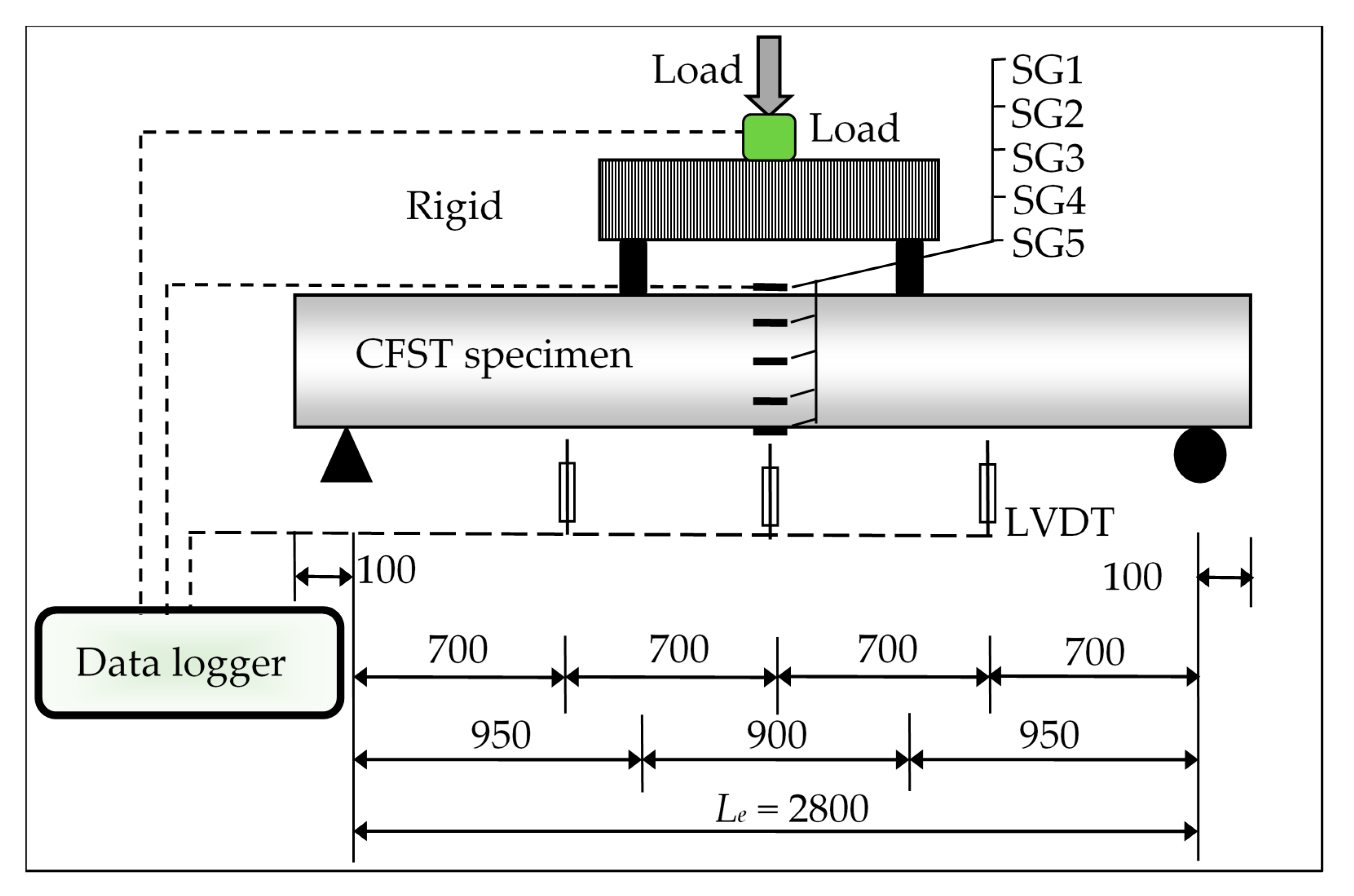
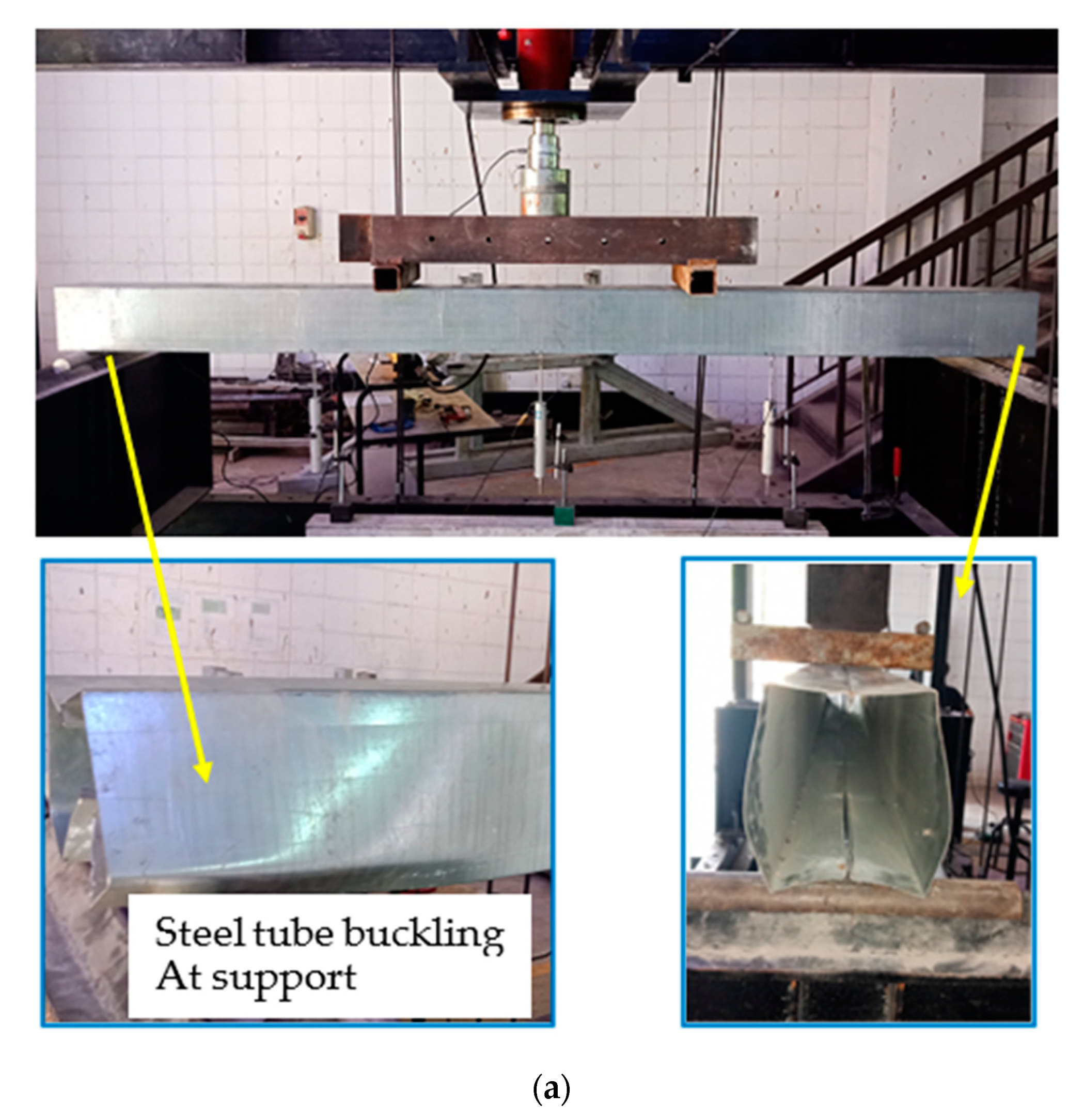
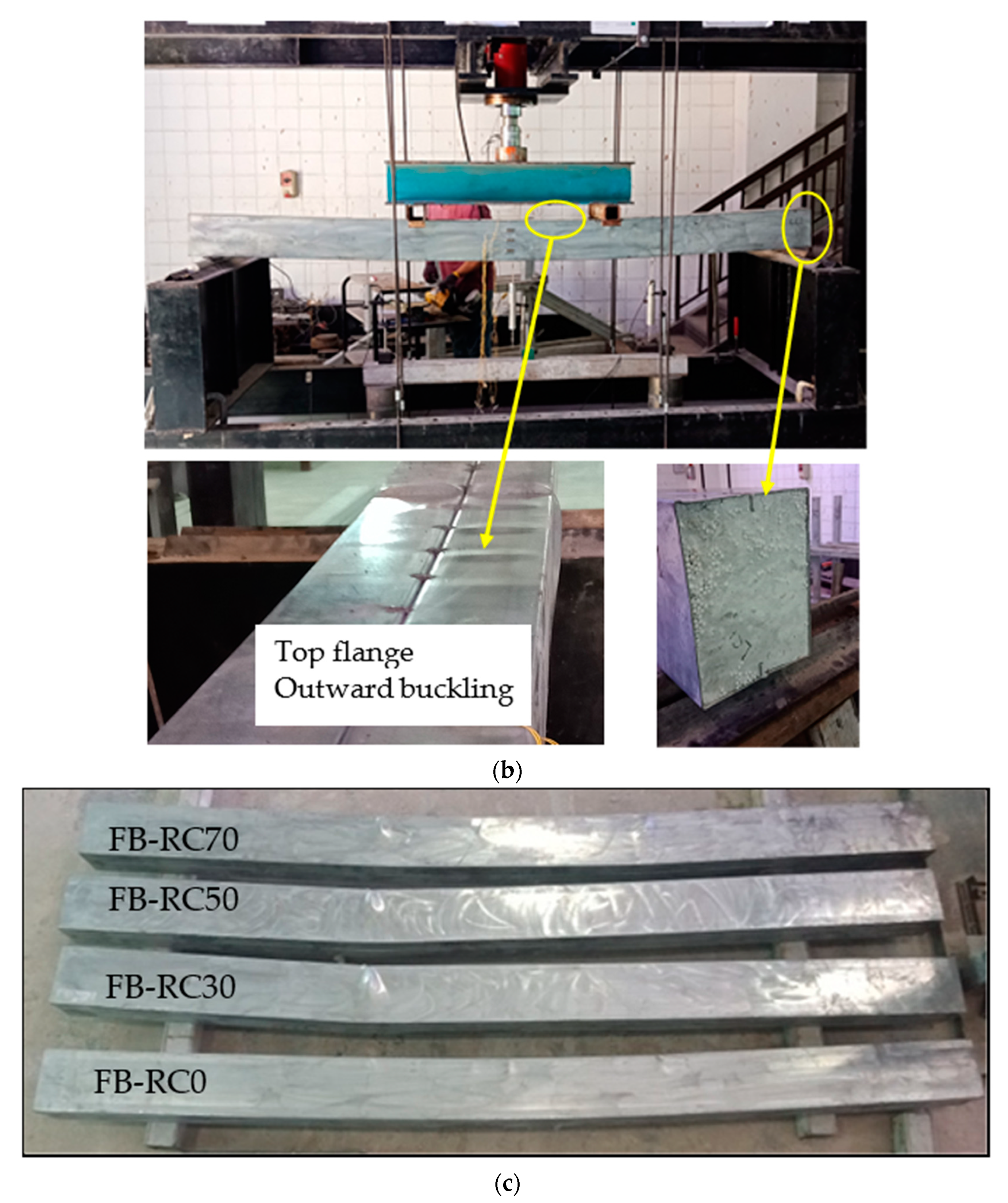
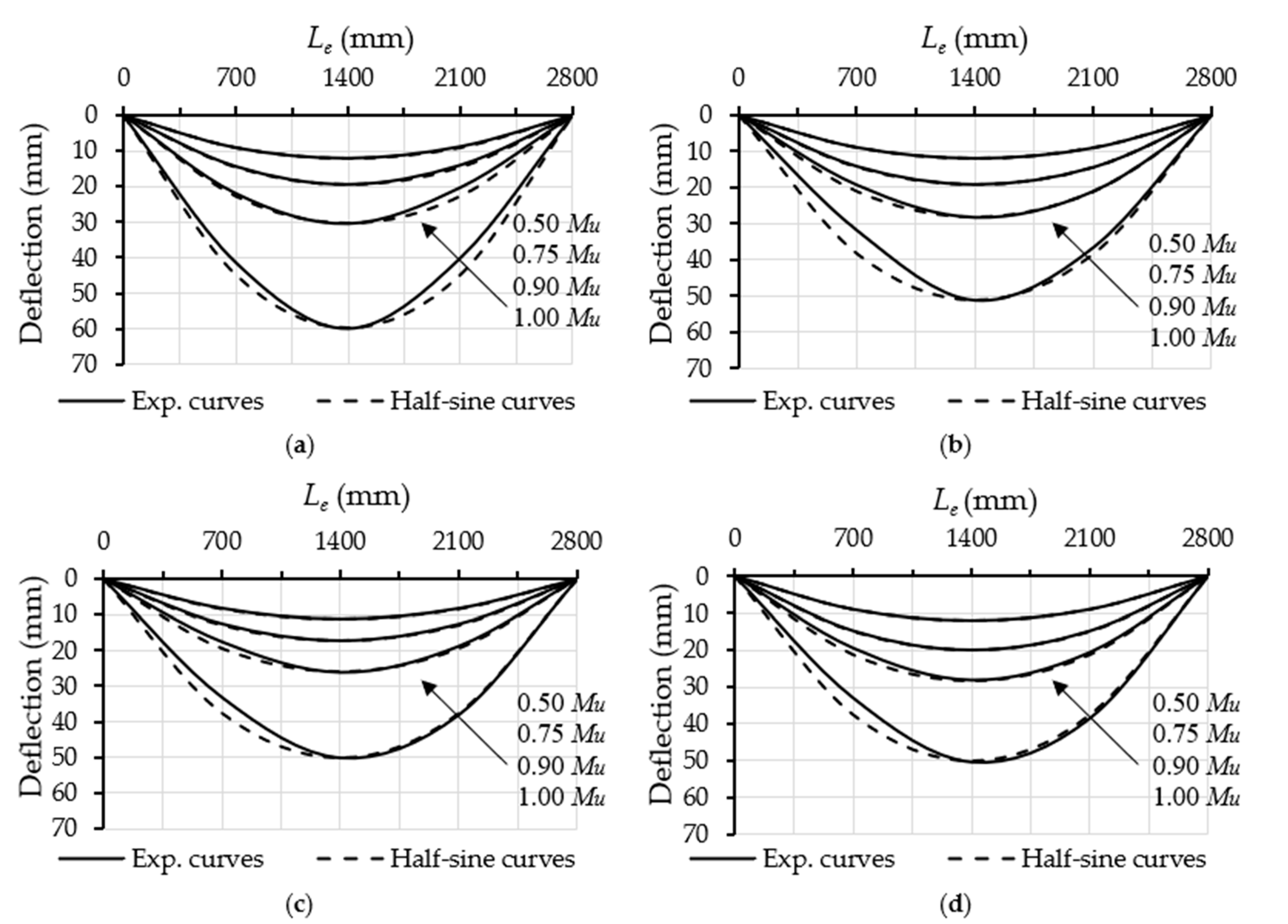
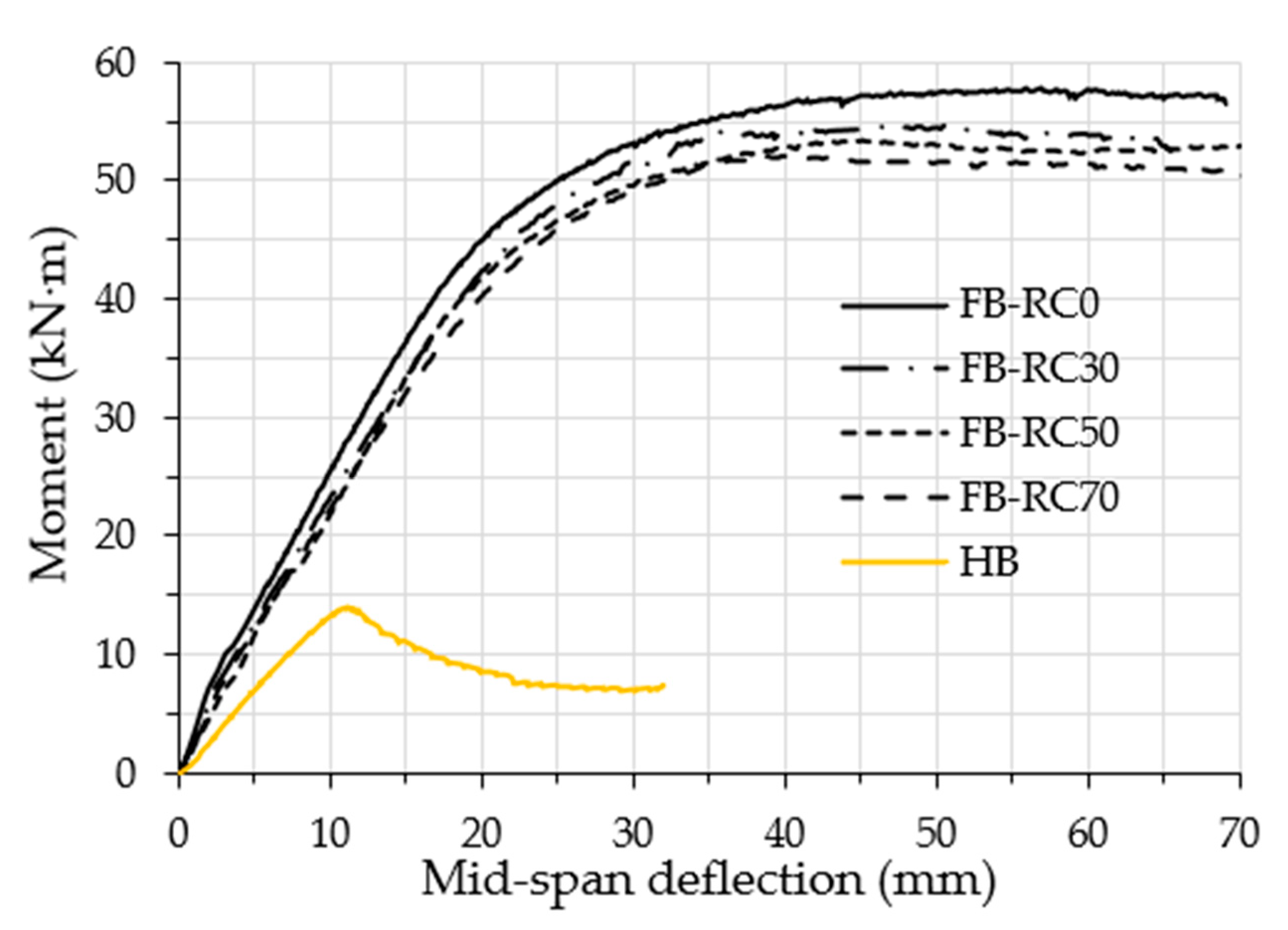
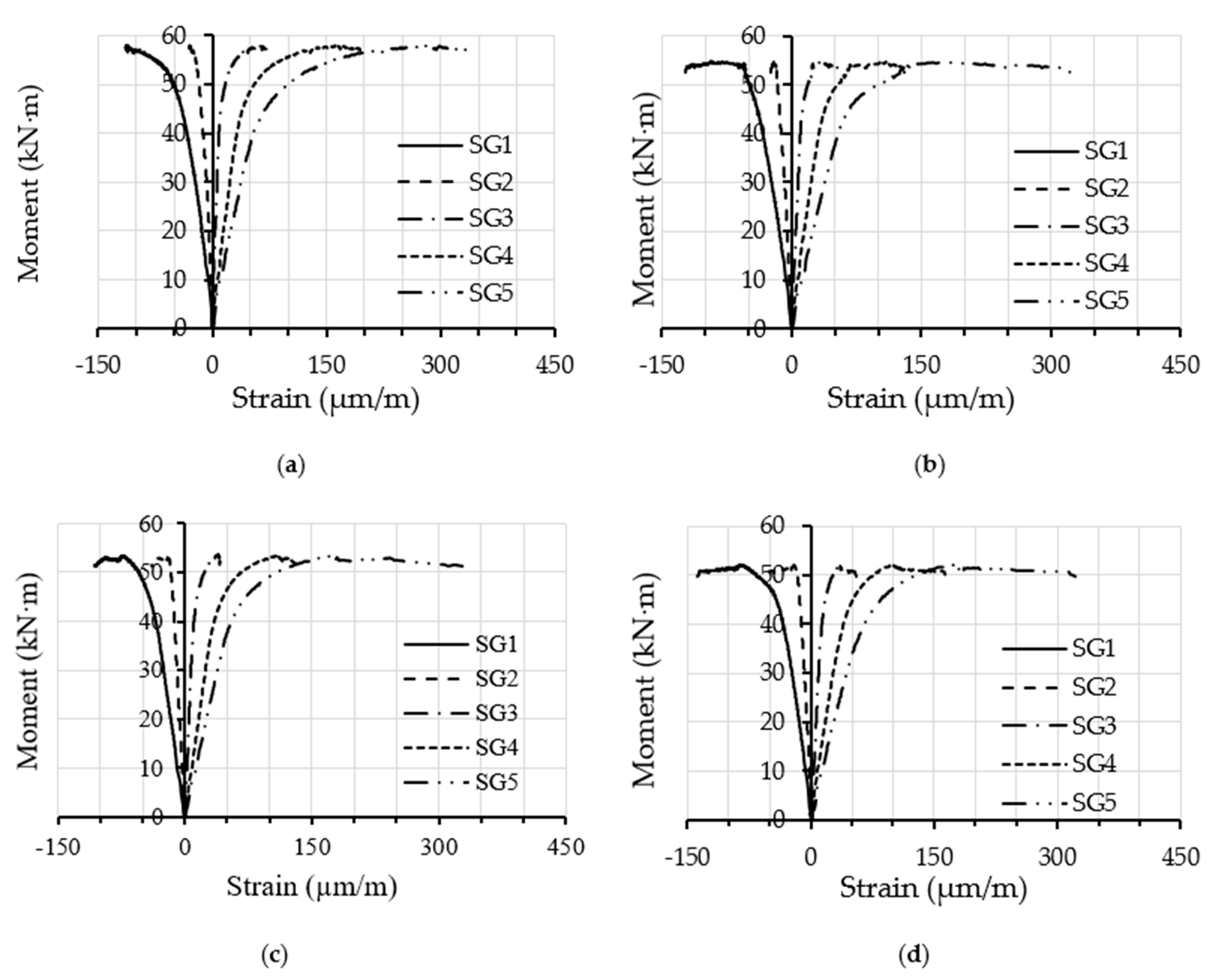
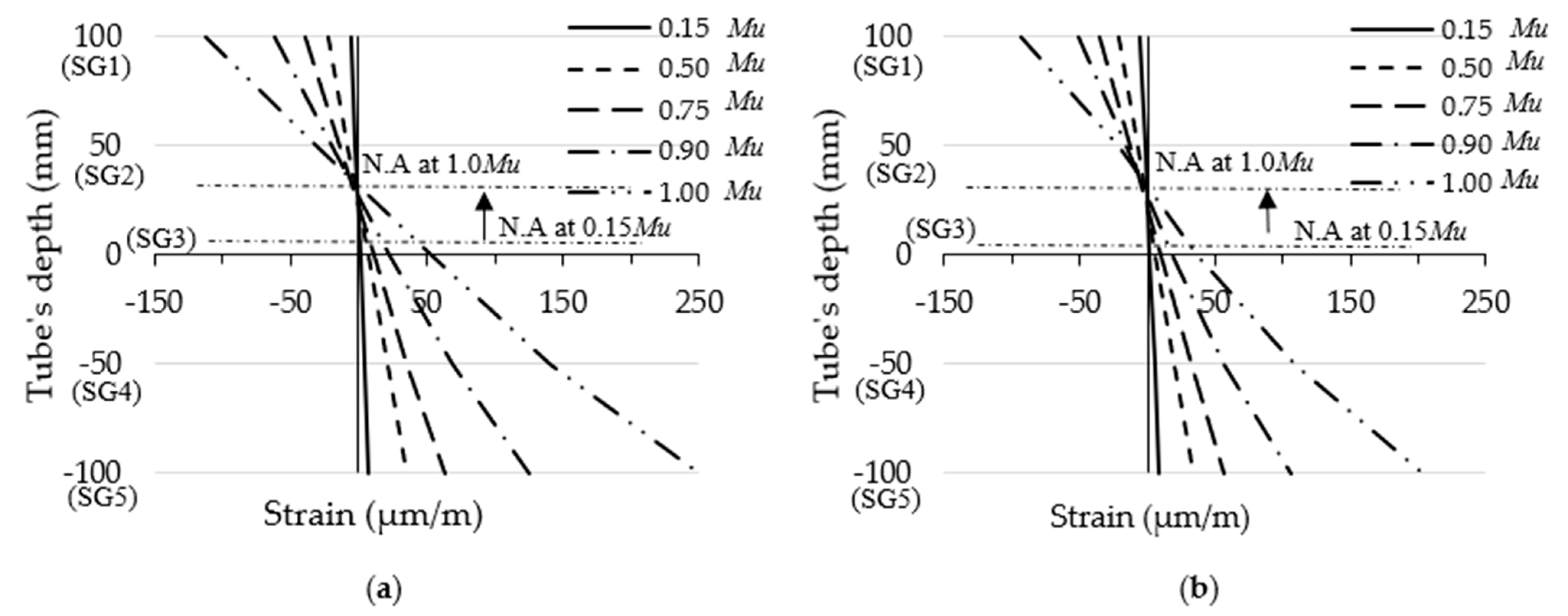
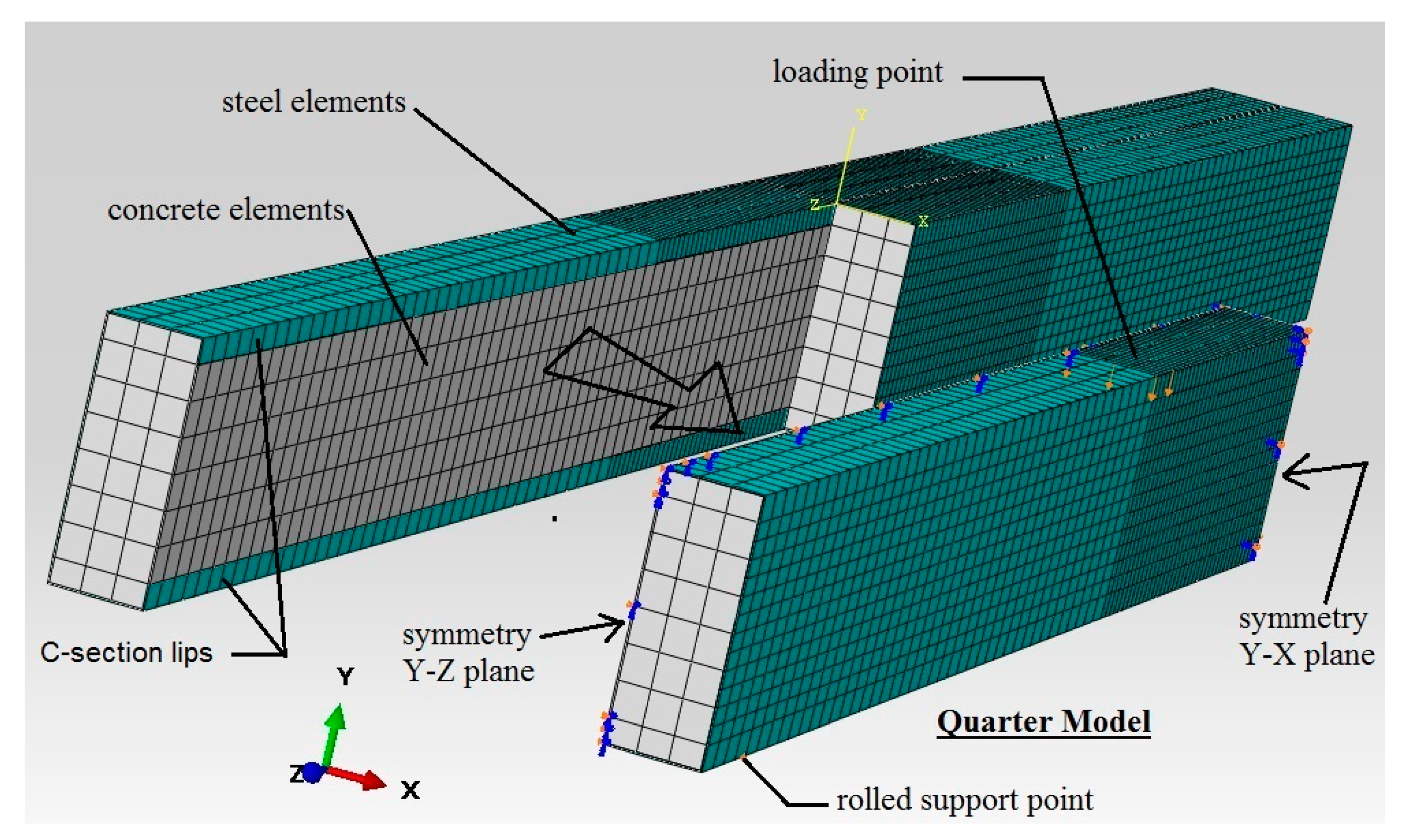
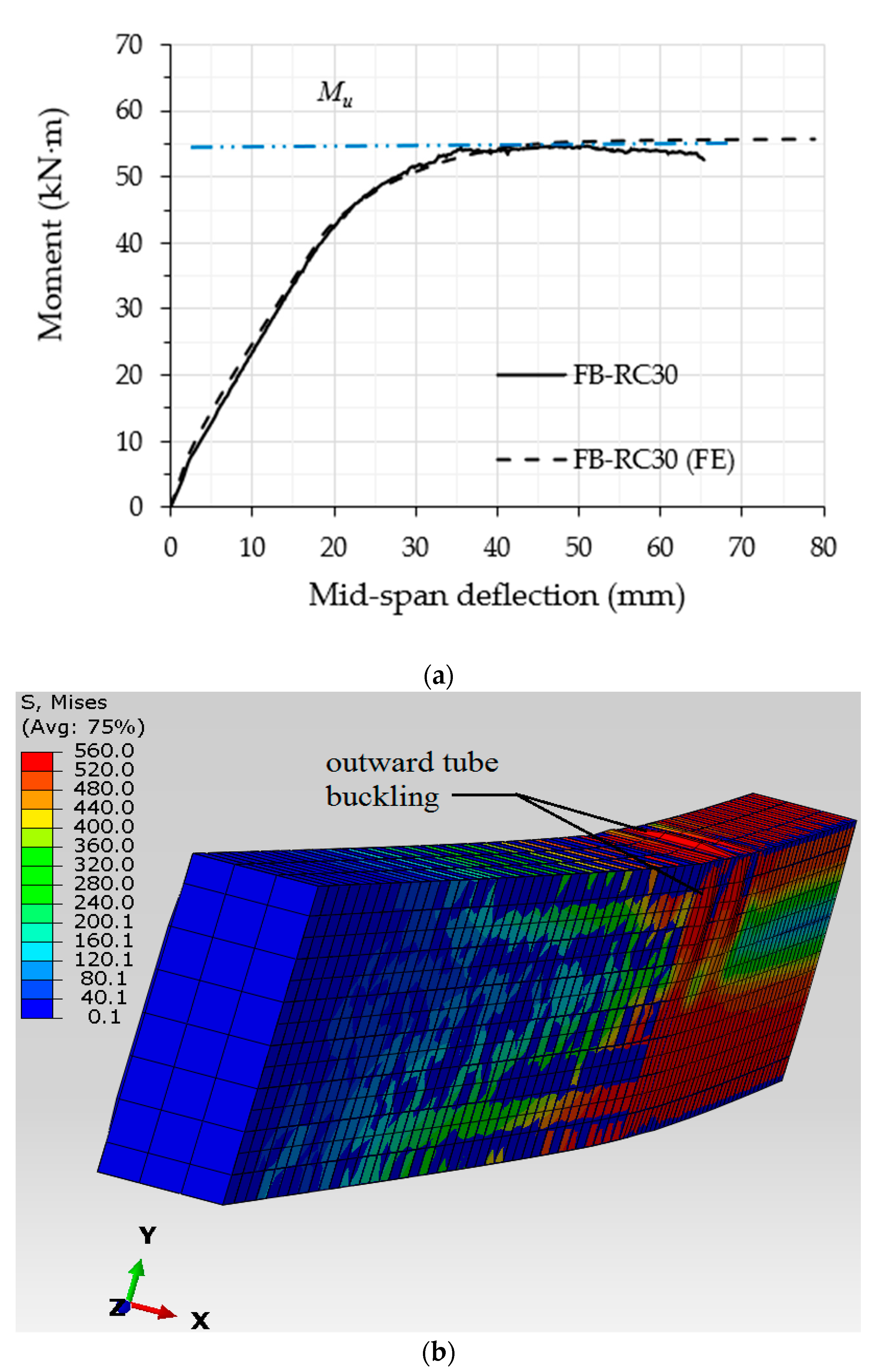
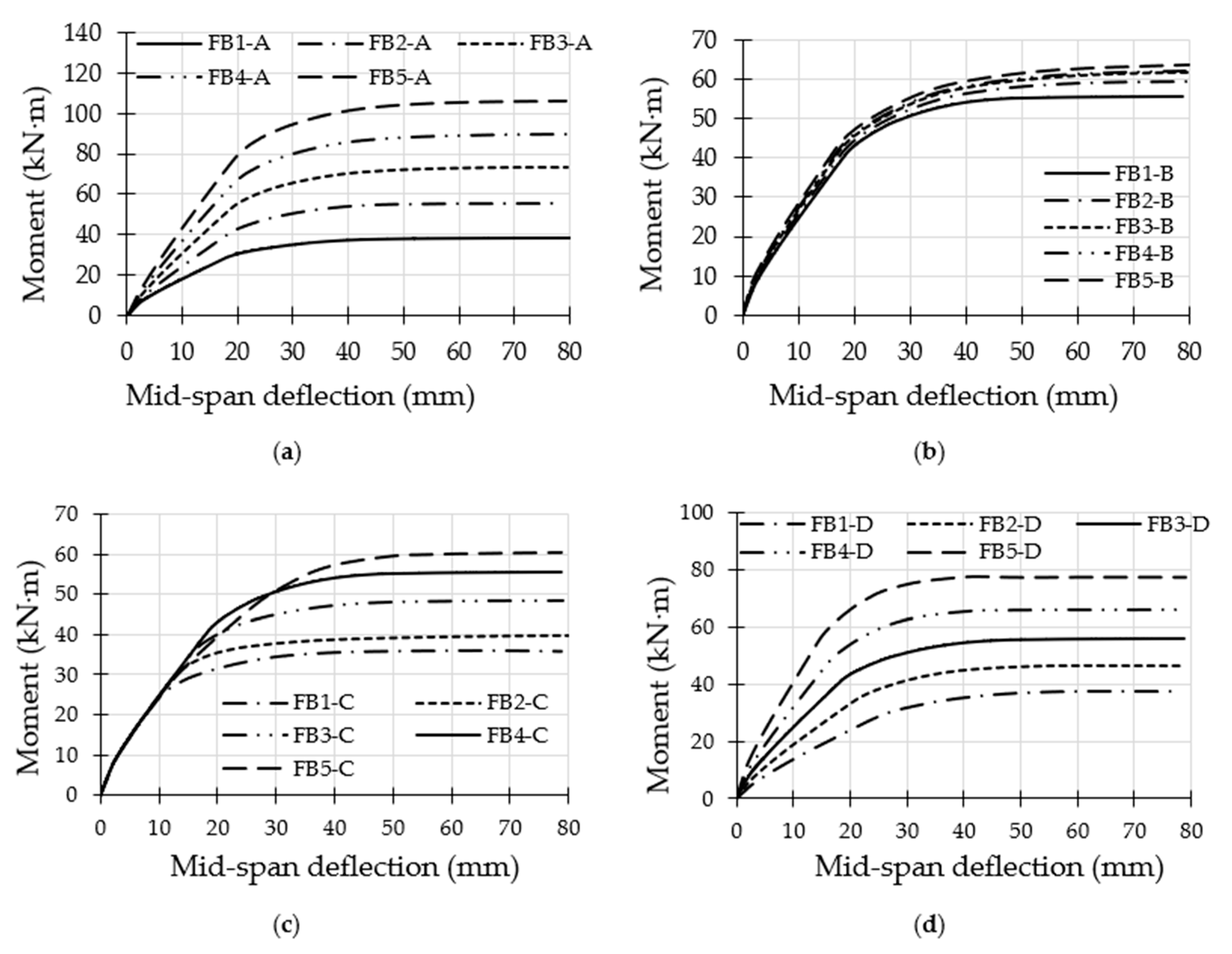
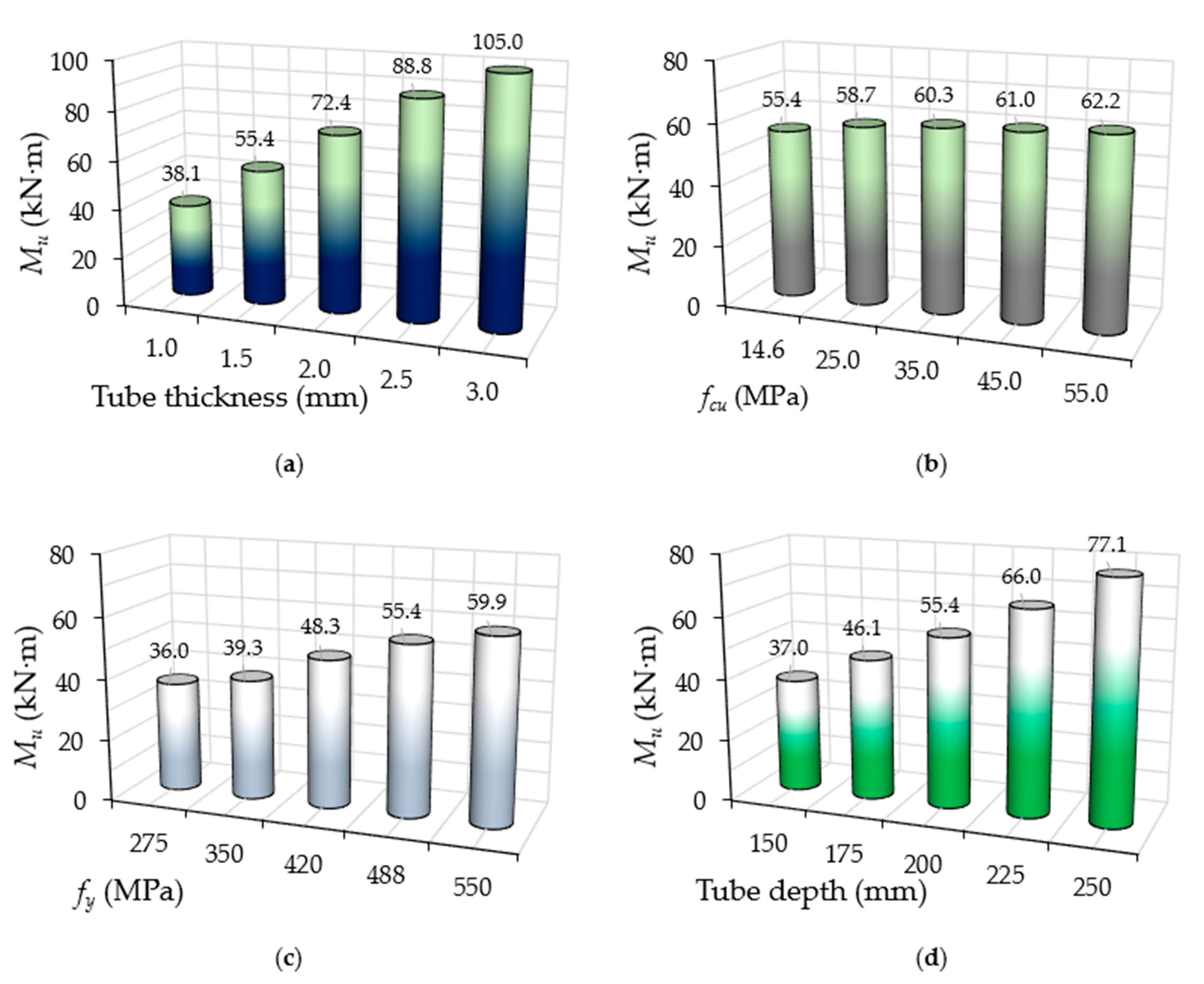
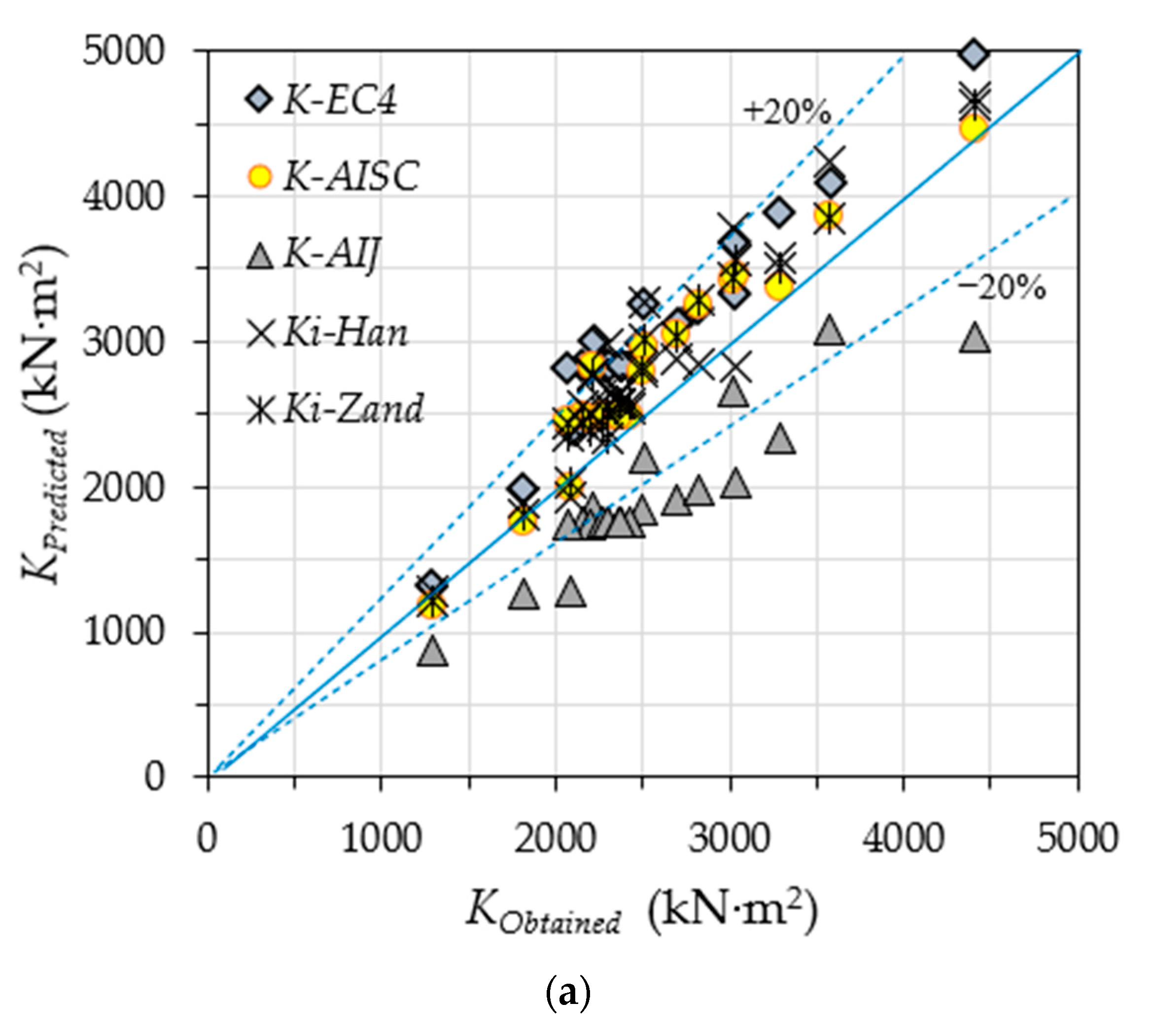
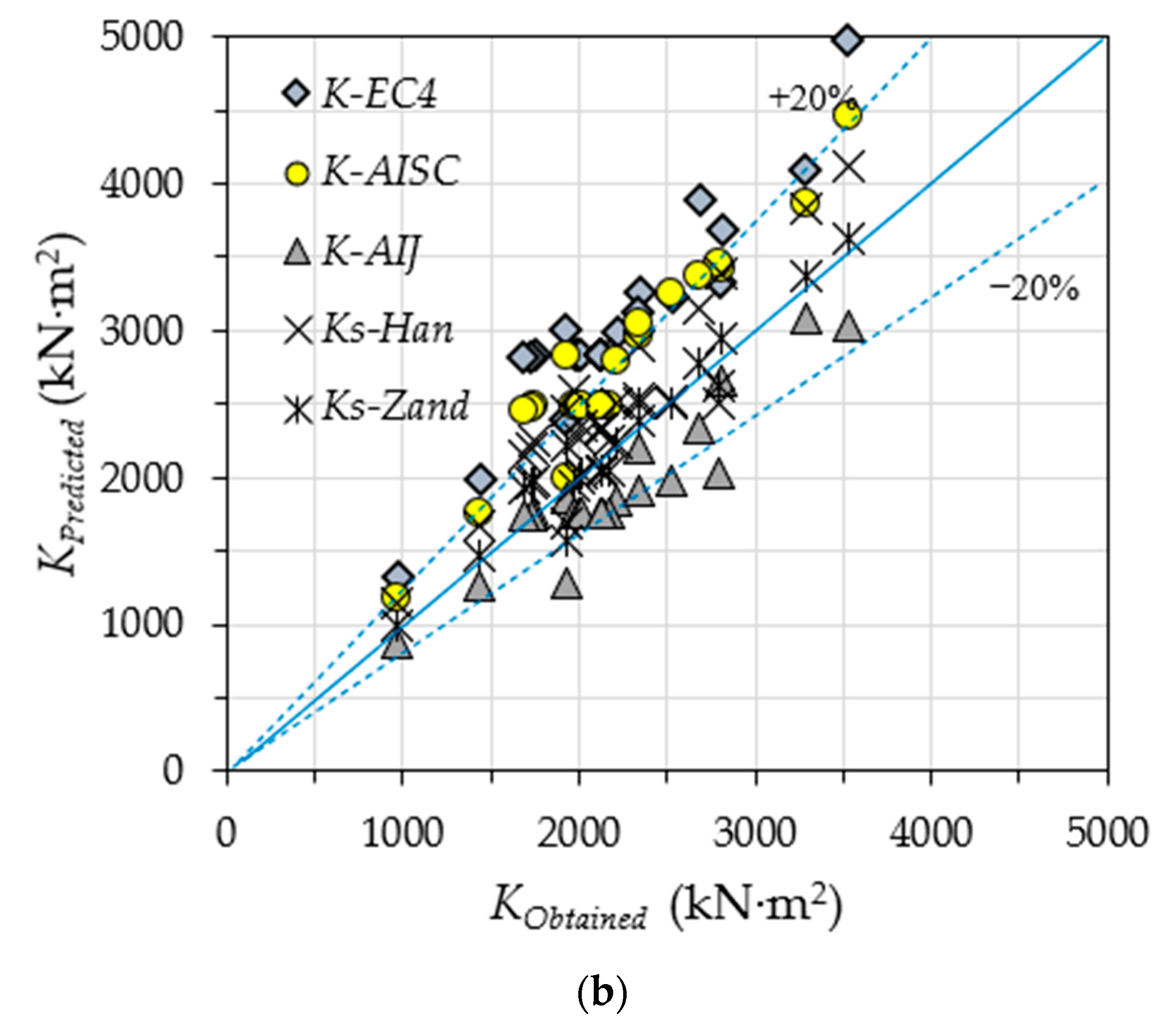
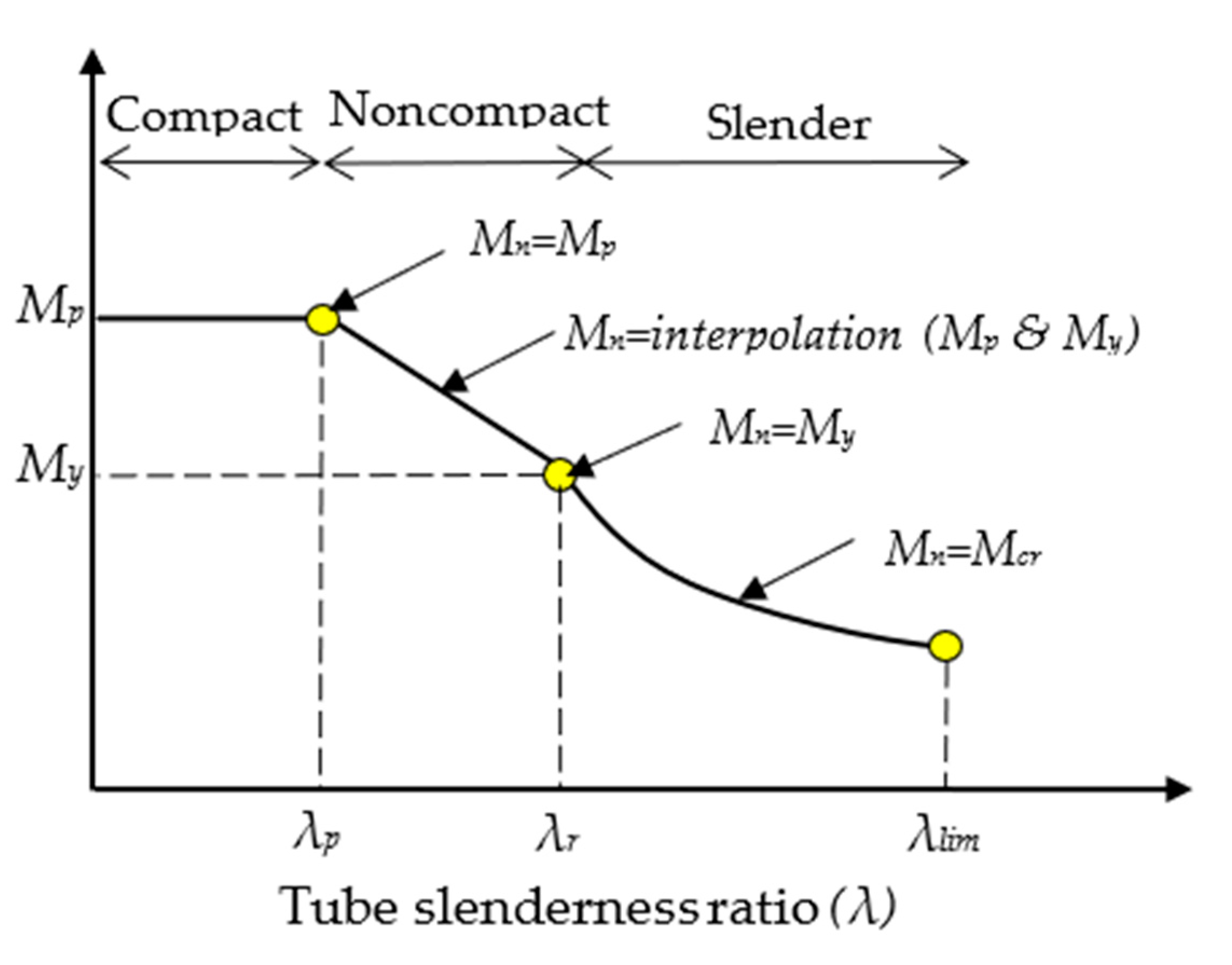
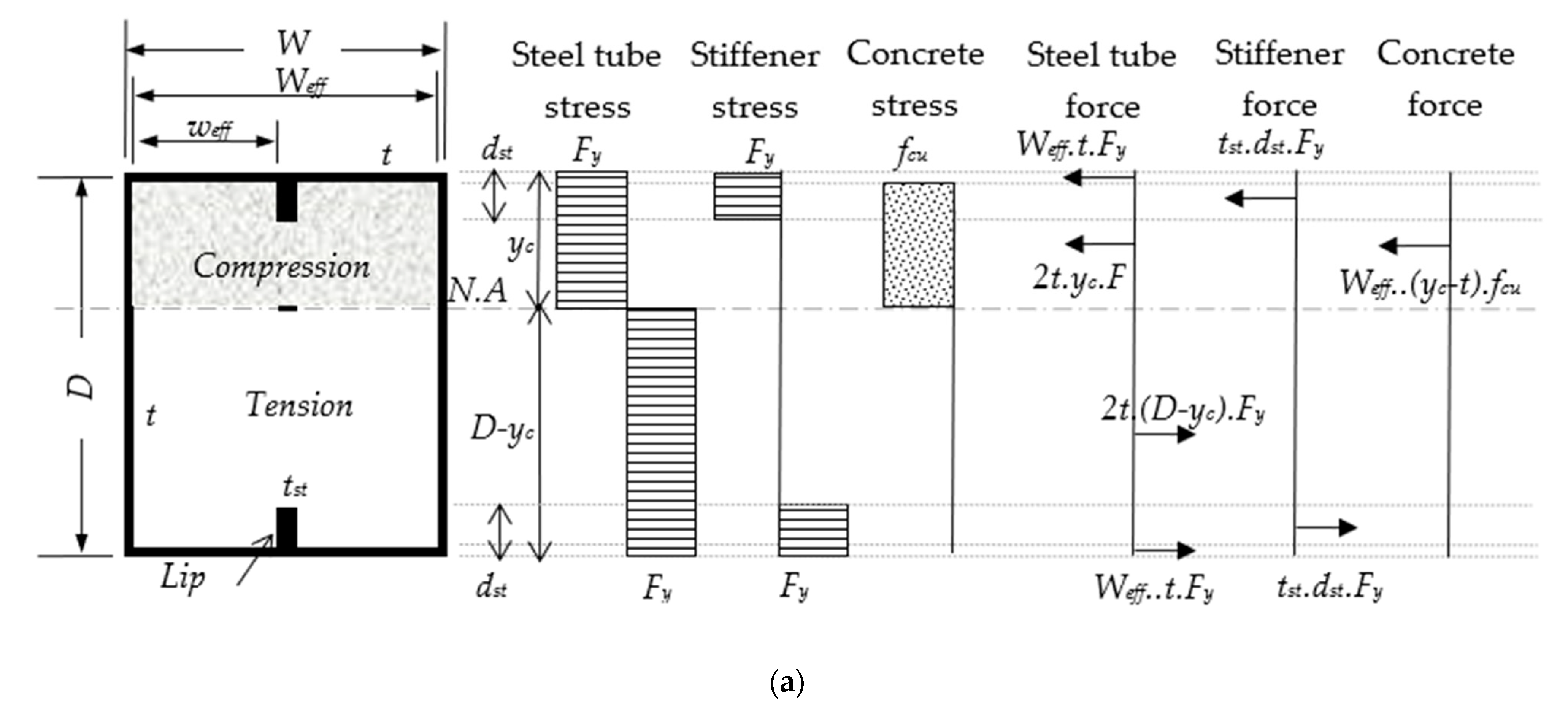
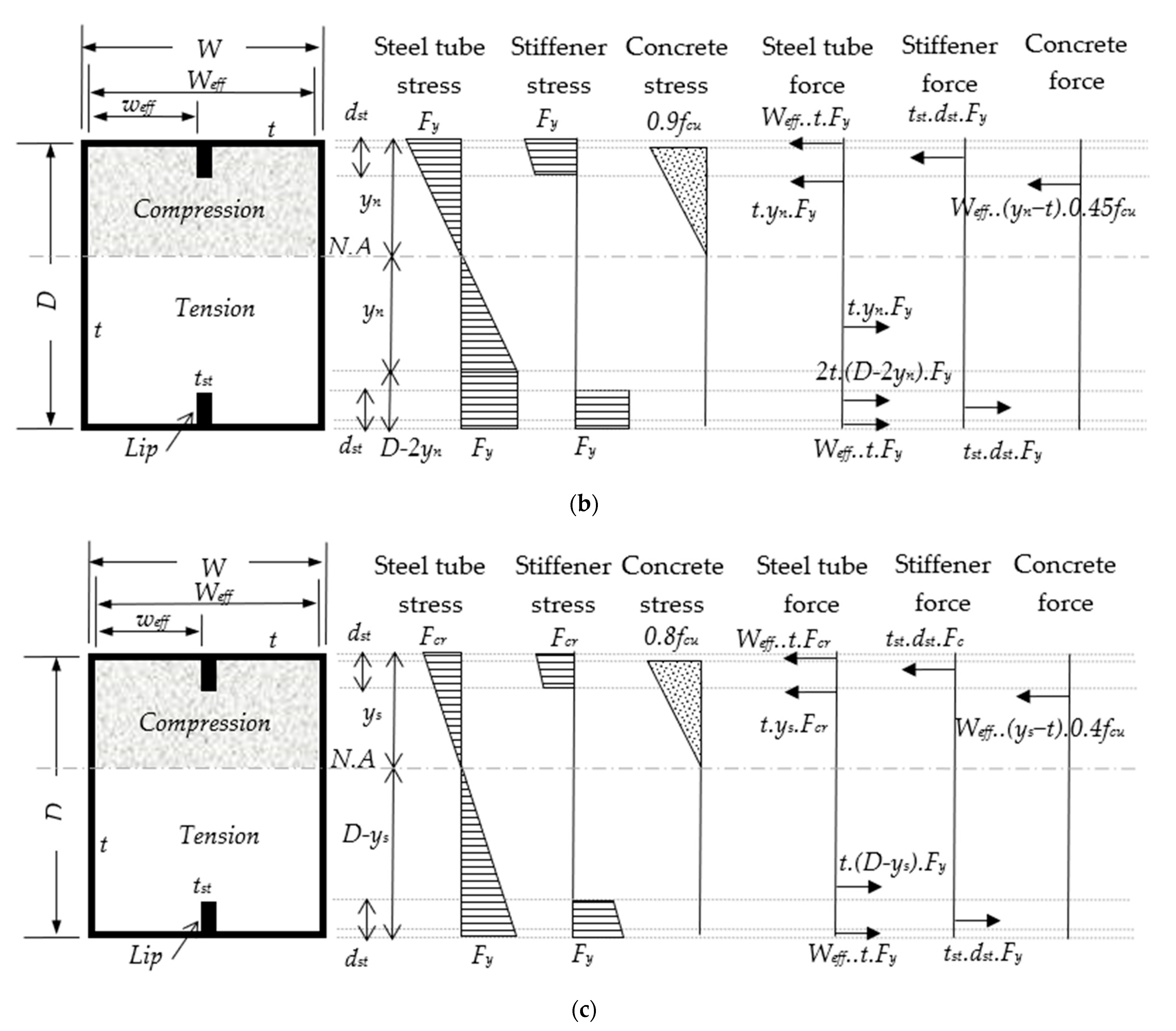
| Specimen Designations | D × B × t (mm) | Le (m) | fy (MPa) | fcu (MPa) | Ec (GPa) | Mu (kN·m) | Ki (kN·m2) | Ks (kN·m2) | EAI (kN·mm) |
|---|---|---|---|---|---|---|---|---|---|
| HB | 200 × 150 × 1.5 | 2.8 | 489 | - | - | 14.1 | 1207 | 1121 | 201.8 |
| FB-RC0 | 200 × 150 × 1.5 | 2.8 | 489 | 26.2 | 21.1 | 57.7 | 2216 | 1924 | 5996 |
| FB-RC30 | 200 × 150 × 1.5 | 2.8 | 489 | 14.6 | 14.5 | 53.7 | 2157 | 1751 | 5539 |
| FB-RC50 | 200 × 150 × 1.5 | 2.8 | 489 | 14.1 | 13.8 | 52.6 | 2194 | 1726 | 5493 |
| FB-RC70 | 200 × 150 × 1.5 | 2.8 | 489 | 13.7 | 13.2 | 51.5 | 2066 | 1690 | 5439 |
| Mixture Designations | Cement | Fine Agg. | Coarse Agg. | Silica Fume | EPS (%) | EPS | RAC (%) | RAC | Water | Slump (mm) | Density |
|---|---|---|---|---|---|---|---|---|---|---|---|
| RC0 | 390 | 700 | 1115 | - | - | - | - | - | 180 | 128 | 2295 |
| RC30 | 350 | 700 | 781 | 40 | 30 | 2.1 | - | - | 180 | 147 | 1881 |
| RC50 | 350 | 700 | 558 | 40 | 30 | 2.1 | 20 | 190 | 180 | 151 | 1813 |
| RC70 | 350 | 700 | 335 | 40 | 30 | 2.1 | 40 | 380 | 180 | 154 | 1772 |
| Models Designation | D × B × t (mm) | fy (MPa) | fcu (MPa) | Ec (GPa) | As (mm2) ×102 | Is (mm4) ×106 | Ac (mm2) ×104 | Ic (mm4) ×107 | Mu (kN·m) | Ki (kN·m2) | Ks (kN·m2) |
|---|---|---|---|---|---|---|---|---|---|---|---|
| FB1-A | 200 × 150 × 1.0 | 489.0 | 14.6 | 16.2 | 7.72 | 4.87 | 2.92 | 9.52 | 38.1 | 2093 | 1929 |
| # FB2-A | 200 × 150 × 1.5 | 489.0 | 14.6 | 16.2 | 11.5 | 7.23 | 2.88 | 9.28 | 55.4 | 2375 | 2125 |
| FB3-A | 200 × 150 × 2.0 | 489.0 | 14.6 | 16.2 | 15.3 | 9.54 | 2.85 | 9.05 | 72.4 | 2511 | 2345 |
| FB4-A | 200 × 150 × 2.5 | 489.0 | 14.6 | 16.2 | 19.0 | 11.8 | 2.81 | 8.82 | 88.8 | 3024 | 2815 |
| FB5-A | 200 × 150 × 3.0 | 489.0 | 14.6 | 16.2 | 22.7 | 14.0 | 2.77 | 8.60 | 105.0 | 3575 | 3285 |
| # FB1-B | 200 × 150 × 1.5 | 489.0 | 14.6 | 16.2 | 11.5 | 7.23 | 2.88 | 9.28 | 55.4 | 2375 | 2125 |
| FB2-B | 200 × 150 × 1.5 | 489.0 | 25.0 | 21.2 | 11.5 | 7.23 | 2.88 | 9.28 | 58.7 | 2491 | 2219 |
| FB3-B | 200 × 150 × 1.5 | 489.0 | 35.0 | 25.0 | 11.5 | 7.23 | 2.88 | 9.28 | 60.3 | 2699 | 2339 |
| FB4-B | 200 × 150 × 1.5 | 489.0 | 45.0 | 28.4 | 11.5 | 7.23 | 2.88 | 9.28 | 61.0 | 2819 | 2529 |
| FB5-B | 200 × 150 × 1.5 | 489.0 | 55.0 | 31.4 | 11.5 | 7.23 | 2.88 | 9.28 | 62.2 | 3033 | 2798 |
| FB1-C | 200 × 150 × 1.5 | 275.0 | 14.6 | 16.2 | 11.5 | 7.23 | 2.88 | 9.28 | 36.0 | 2293 | 1978 |
| FB2-C | 200 × 150 × 1.5 | 350.0 | 14.6 | 16.2 | 11.5 | 7.23 | 2.88 | 9.28 | 39.3 | 2274 | 1998 |
| FB3-C | 200 × 150 × 1.5 | 420.0 | 14.6 | 16.2 | 11.5 | 7.23 | 2.88 | 9.28 | 48.3 | 2302 | 2011 |
| # FB4-C | 200 × 150 × 1.5 | 489.0 | 14.6 | 16.2 | 11.5 | 7.23 | 2.88 | 9.28 | 55.4 | 2375 | 2125 |
| FB5-C | 200 × 150 × 1.5 | 550.0 | 14.6 | 16.2 | 11.5 | 7.23 | 2.88 | 9.28 | 59.9 | 2432 | 2173 |
| FB1-D | 150 × 150 × 1.5 | 489.0 | 14.6 | 16.2 | 10.0 | 3.74 | 2.15 | 3.85 | 37.0 | 1287 | 978 |
| FB2-D | 175 × 150 × 1.5 | 489.0 | 14.6 | 16.2 | 10.8 | 5.32 | 2.52 | 6.17 | 46.1 | 1814 | 1436 |
| # FB3-D | 200 × 150 × 1.5 | 489.0 | 14.6 | 16.2 | 11.5 | 7.23 | 2.88 | 9.28 | 55.4 | 2375 | 2125 |
| FB4-D | 225 × 150 × 1.5 | 489.0 | 14.6 | 16.2 | 12.3 | 9.51 | 3.25 | 13.3 | 66.0 | 3286 | 2686 |
| FB5-D | 250 × 150 × 1.5 | 489.0 | 14.6 | 16.2 | 13.0 | 12.2 | 3.62 | 18.3 | 77.1 | 4407 | 3530 |
| Model Designations | λ (W/t) | λst (Weff/t) | Mu (kN.m) | Mu-EC4 (kN.m) | Mu-EC4 /Mu | Mu-Han (kN·m) | Mu-Han /Mu | Mu-P1 (kN·m) | Mu-P1 /Mu | Mn (kN·m) | Mn /Mu |
|---|---|---|---|---|---|---|---|---|---|---|---|
| FB-RC0 | 98.0 | 48.0 | 57.7 | 39.1 | 0.678 | 42.3 | 0.732 | 42.6 | 0.738 | 48.9 | 0.848 |
| FB-RC30 | 98.0 | 48.0 | 53.7 | 37.3 | 0.694 | 39.3 | 0.731 | 37.2 | 0.692 | 46.7 | 0.870 |
| FB-RC50 | 98.0 | 48.0 | 52.6 | 37.2 | 0.706 | 39.2 | 0.745 | 36.8 | 0.700 | 46.6 | 0.886 |
| FB-RC70 | 98.0 | 48.0 | 51.5 | 37.1 | 0.720 | 39.1 | 0.759 | 36.5 | 0.709 | 46.5 | 0.903 |
| FB1-A | 148.0 | 73.0 | 38.1 | 25.8 | 0.678 | 27.2 | 0.713 | 27.1 | 0.711 | 30.1 | 0.789 |
| FB2-A | 98.0 | 48.0 | 55.4 | 37.2 | 0.671 | 39.2 | 0.707 | 37.1 | 0.670 | 46.7 | 0.842 |
| FB3-A | 73.0 | 35.5 | 72.4 | 48.2 | 0.665 | 51.7 | 0.714 | 48.6 | 0.671 | 61.4 | 0.848 |
| FB4-A | 58.0 | 28.0 | 88.8 | 58.8 | 0.663 | 64.8 | 0.730 | 61.7 | 0.695 | 75.1 | 0.846 |
| FB5-A | 48.0 | 23.0 | 105.0 | 69.3 | 0.660 | 78.5 | 0.747 | 68.0 | 0.647 | 88.6 | 0.844 |
| FB1-B | 98.0 | 48.0 | 55.4 | 37.2 | 0.671 | 39.2 | 0.707 | 37.1 | 0.670 | 46.7 | 0.842 |
| FB2-B | 98.0 | 48.0 | 58.7 | 38.9 | 0.663 | 41.9 | 0.713 | 42.1 | 0.717 | 48.6 | 0.829 |
| FB3-B | 98.0 | 48.0 | 60.3 | 40.0 | 0.663 | 44.5 | 0.738 | 45.5 | 0.755 | 49.9 | 0.827 |
| FB4-B | 98.0 | 48.0 | 61.0 | 40.8 | 0.669 | 46.9 | 0.769 | 49.3 | 0.809 | 50.7 | 0.832 |
| FB5-B | 98.0 | 48.0 | 62.2 | 41.4 | 0.666 | 49.1 | 0.789 | 53.7 | 0.863 | 51.4 | 0.826 |
| FB1-C | 98.0 | 48.0 | 36.0 | 22.0 | 0.611 | 23.7 | 0.660 | 23.9 | 0.665 | 27.8 | 0.772 |
| FB2-C | 98.0 | 48.0 | 39.3 | 27.4 | 0.697 | 29.1 | 0.741 | 28.9 | 0.735 | 34.7 | 0.883 |
| FB3-C | 98.0 | 48.0 | 48.3 | 32.4 | 0.671 | 34.2 | 0.708 | 33.2 | 0.688 | 41.1 | 0.851 |
| FB4-C | 98.0 | 48.0 | 55.4 | 37.2 | 0.671 | 39.2 | 0.707 | 37.1 | 0.670 | 46.7 | 0.842 |
| FB5-C | 98.0 | 48.0 | 59.9 | 41.5 | 0.693 | 43.8 | 0.731 | 40.4 | 0.674 | 51.1 | 0.853 |
| FB1-D | 98.0 | 48.0 | 37.0 | 24.5 | 0.662 | 25.4 | 0.688 | 23.4 | 0.632 | 31.0 | 0.839 |
| FB2-D | 98.0 | 48.0 | 46.1 | 30.6 | 0.663 | 32.0 | 0.694 | 29.9 | 0.649 | 38.5 | 0.836 |
| FB3-D | 98.0 | 48.0 | 55.4 | 37.2 | 0.671 | 39.2 | 0.707 | 37.1 | 0.670 | 46.7 | 0.842 |
| FB4-D | 98.0 | 48.0 | 66.0 | 44.4 | 0.672 | 47.1 | 0.713 | 45.0 | 0.682 | 55.4 | 0.839 |
| FB5-D | 98.0 | 48.0 | 77.1 | 52.1 | 0.676 | 55.7 | 0.722 | 53.6 | 0.695 | 64.8 | 0.840 |
| # SB2-SI (St1.5) | 131.3 | 65.2 | 60.1 | 35.0 | 0.584 | 45.4 | 0.755 | 53.1 | 0.885 | 43.2 | 0.719 |
| # SB2-SI (St3.0) | 131.3 | 64.7 | 64.2 | 35.3 | 0.550 | 51.3 | 0.799 | 56.8 | 0.884 | 48.1 | 0.749 |
| # SB2-SI (St4.5) | 131.3 | 64.2 | 69.7 | 35.6 | 0.510 | 57.2 | 0.820 | 60.9 | 0.873 | 53.6 | 0.768 |
| # SB3-DI (St1.5) | 131.3 | 43.1 | 65.5 | 35.3 | 0.539 | 50.9 | 0.777 | 56.5 | 0.863 | 50.3 | 0.769 |
| # SB3-DI (St3.0) | 131.3 | 42.4 | 76.5 | 35.8 | 0.468 | 63.0 | 0.823 | 65.4 | 0.854 | 62.4 | 0.816 |
| # SB3-DI (St4.5) | 131.3 | 41.8 | 88.0 | 36.4 | 0.413 | 74.6 | 0.848 | 75.3 | 0.856 | 76.6 | 0.870 |
| MV | - | - | - | - | 0.643 | - | 0.740 | - | 0.734 | - | 0.831 |
| COV | - | - | - | - | 0.112 | - | 0.057 | - | 0.110 | - | 0.049 |
Publisher’s Note: MDPI stays neutral with regard to jurisdictional claims in published maps and institutional affiliations. |
© 2021 by the authors. Licensee MDPI, Basel, Switzerland. This article is an open access article distributed under the terms and conditions of the Creative Commons Attribution (CC BY) license (https://creativecommons.org/licenses/by/4.0/).
Share and Cite
Al Zand, A.W.; Ali, M.M.; Al-Ameri, R.; Badaruzzaman, W.H.W.; Tawfeeq, W.M.; Hosseinpour, E.; Yaseen, Z.M. Flexural Strength of Internally Stiffened Tubular Steel Beam Filled with Recycled Concrete Materials. Materials 2021, 14, 6334. https://doi.org/10.3390/ma14216334
Al Zand AW, Ali MM, Al-Ameri R, Badaruzzaman WHW, Tawfeeq WM, Hosseinpour E, Yaseen ZM. Flexural Strength of Internally Stiffened Tubular Steel Beam Filled with Recycled Concrete Materials. Materials. 2021; 14(21):6334. https://doi.org/10.3390/ma14216334
Chicago/Turabian StyleAl Zand, Ahmed W., Mustafa M. Ali, Riyadh Al-Ameri, Wan Hamidon Wan Badaruzzaman, Wadhah M. Tawfeeq, Emad Hosseinpour, and Zaher Mundher Yaseen. 2021. "Flexural Strength of Internally Stiffened Tubular Steel Beam Filled with Recycled Concrete Materials" Materials 14, no. 21: 6334. https://doi.org/10.3390/ma14216334
APA StyleAl Zand, A. W., Ali, M. M., Al-Ameri, R., Badaruzzaman, W. H. W., Tawfeeq, W. M., Hosseinpour, E., & Yaseen, Z. M. (2021). Flexural Strength of Internally Stiffened Tubular Steel Beam Filled with Recycled Concrete Materials. Materials, 14(21), 6334. https://doi.org/10.3390/ma14216334









